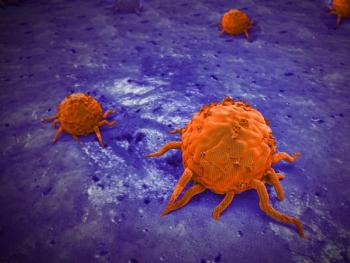
Etigilimab Plus Nivolumab Demonstrates Tolerability in Advanced Solid Tumors
Results from the phase 1b/2 ACTIVATE trial showed tolerability among the combination of etigilimab plus nivolumab in patients with recurrent or advanced solid tumors.
Tolerability and potential efficacy was observed with etigilimab (MPH313) and nivolumab (Opdivo) for patients with recurrent or advanced solid tumors and those with PD-L1 low disease, according to an update from select cohorts of the phase 1b/2 ACTIVATE study (NCT04761198) presented at the
At the March 29, 2023, data cutoff, the objective response rate (ORR) was 25% in a total of 40 patients treated with the combination therapy including those from the checkpoint-inhibitor-naïve endometrial cancer (n = 10), cervical cancer (n = 8), uveal melanoma (n = 8), de-differentiated liposarcoma (n = 10), and germ cell tumor (n = 4) cohorts.
The only complete responses (CRs) occurred in 3 patients in the cervical cancer cohort who received treatment for a median of 12.5 months. Partial responses (PRs) were reported in the endometrial (n = 3), uveal melanoma (n = 2), de-differentiated liposarcoma (n = 1), and germ cell tumor (n = 1) cohorts for a total of 7 PRs; these patients received treatment for a median of 12.0 months. Additionally, 11 patients experienced stable disease (SD) and 19 patients experienced progressive disease. Patients with SD received treatment for a median of 6.25 months.1
“Several patients with SD did have tumor shrinkage and several of these PRs were deep responses,” Meredith Mckean, MD, MPH, who is the director of the Melanoma and Skin Cancer Research Program at Sarah Cannon Research Institute in Nashville, Tennessee, explained. “The swimmers plot [shows] these responses were very durable; there was a number of patients that were still on treatment at the time of the data cut [off] and even patients with SD did remain on study for a period of time.”
A significant number of patients who responded to treatment with etigilimab plus nivolumab had PD-L1-low disease. Six of 7 patients who received treatment for at least 11 months had PD-L1-negative or PD-1-low disease and all 7 patients had high PVR tumor expression.
In addition to PD-L1 low status, biomarkers were of interest in the study as Mckean noted that “there’s a correlation of CD226- and CD8-positive co-expression observed in patients with objective response particularly in cervical cancer and uveal melanoma, potentially serving as a biomarker in the future.” There was also robust target engagement seen including sustained activation of T-cell subsets and reductions of Tregs—total CD8 T-cell frequencies remained stable.
The ACTIVATE trial enrolled 72 patients with advanced or metastatic solid tumors that do not have any curative or standard of care therapies available. Those in the cervical carcinoma (n = 8), endometrial carcinoma (n = 10), ovarian cancer (n = 10), germ cell tumor (n = 6), sarcoma (n = 16) encompassing de-differentiated liposarcoma and undifferentiated pleomorphic sarcoma, and uveal melanoma (n = 8) cohorts had not received a prior checkpoint inhibitor. Patients in the high tumor mutation burden and microsatellite stable (n = 9) as well as the endometrial carcinoma (n = 5) cohorts could have previously received a checkpoint inhibitor.1
Mckean noted that the tumor types were “were selected due to their known high expression of TGIT and PVR and known co-expression of TGIT and PD-1. Notably, several of these tumor types are known to have low responses to anti-PD-1 monotherapy.”
The combination of etigilimab and nivolumab was well tolerated and there were no new safety signals observed during the study. In the safety population (n = 76) serious treatment-emergent adverse effects (TEAEs) occurred in 28.9% of patients and grade 3 or higher TEAEs occurred in 40.8% of patients.
Any grade treatment-related AEs (TRAEs) were more commonly attributed to nivolumab (72.4%) than etigilimab (68.4%) and were also attributed to the combination (65.8%). The most common any grade TRAEs included rashes (42.1%), gastrointestinal encompassing nausea and diarrhea (27.6%), and general symptoms (26.3%). Additionally, 6 patients experienced grade 1 to 2 infusion reactions.
Grade 3 or higher TRAEs occurred in 11.8% of patients and included type 1 diabetes, maculopapular rash, hepatobiliary disorder, pneumonitis, hematemesis, immune mediated gastritis, transaminitis, decreased neutrophil count, and adrenal insufficiency. Further, 4 patients discontinued treatment due to a TRAE. No deaths related to treatment were reported.1
Patients enrolled were aged 18 years or older and those in the cervical cancer cohort had a PD-L1 combined positive score of at least 1%. Patients with an HIV infection or active hepatitis B or C were not enrolled. The primary end point of the study was investigator assessed ORR by RECIST 1.1 and secondary end points included duration of response and safety.
Intravenous (IV) etigilimab was administered every 2 weeks with IV nivolumab 240 mg every 2 weeks. Etigilimab is an IgG1 antibody that binds to the Fc-receptor and promotes myeloid cell activation and antibody-dependent cellular cytotoxicity.
Mckean explained that etigilimab is “notably distinct from Fc-receptor silent antibodies by reducing Tregs and promoting myeloid cell activation. [It is] differentiated from Fc-receptor enabled antibodies by optimized affinity to significantly reduce Tregs while total CD8 frequencies remain constant, thus retaining immune cells for enhanced tumor cell killing and [an] optimal safety profile.”
The last dose of etigilimab was administered on June 26, 2023, and ACTIVATE is now complete. Investigators noted that the cervical cancer and uveal melanoma cohorts have cleared the protocol Simon 2 Stage design interim futility monitoring bar for expansion to phase 2—the cohorts were also endorsed by an independent data monitoring committee for expansion. However, the checkpoint inhibitor-naïve endometrial cancer, de-differentiated liposarcoma, and germ cell tumor cohorts have not undergone official evaluation for futility, although Mckean noted they may show promise.
Reference
Mckean M, Dumbrava EE, Hamid O, et al. Safety and efficacy of etigilimab (anti-TIGIT) with nivolumab (anti-PD1) in recurrent/advanced solid tumors. Ann Oncol. 2023;34(suppl 2):S621-S622. doi:10.1016/j.annonc.2023.09.2160
Newsletter
Stay up to date on recent advances in the multidisciplinary approach to cancer.



















































































